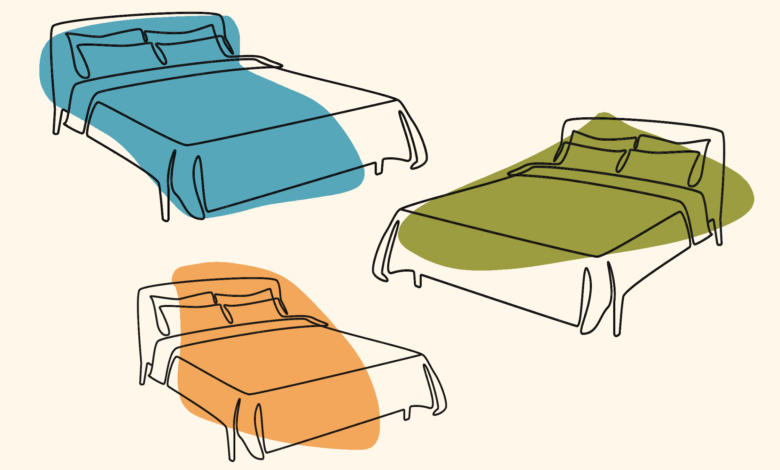Mattress Sizes and Dimensions: Your Guide for Bed-Buying

Some of our favorite queen-size mattresses:
How to pick the right size mattress for your bedroom
Allow us to state the obvious: When buying a mattress, “room size is an important consideration,” Dr. Jackson says. Here’s how big your bedroom should ideally be for each mattress size, according to requirements from the Americans with Disabilities Act (ADA) for residential dwellings, which recommend at least 36 inches (or 3 feet) of space surrounding a bed.
Smaller or narrower rooms (say anything under 9 ½ by 7 ½ feet, the smallest ADA-approved size room to fit a full mattress) do well with twin beds. These mattresses still fit in larger bedrooms, of course, but if you go this route, you may want to fill out your space with other large furniture items so it doesn’t feel sparse.
This mattress is the same distance across as a standard twin, but it’s four inches longer — so your bedroom will need to be at least that much bit bigger too.
A bedroom at least 9 ½ by 7 ½ feet can fit a full size mattress, according to the ADA.
To upgrade from a full to a queen, your bedroom should be at least 116 inches (9 ½ feet) by 96 inches (8 feet). As long as your room is spacious enough, this mattress is a popular choice: “[Many] people opt for a queen size mattress as a nice mix of sleeping space and maintaining adequate floor space in the bedroom,” says Dr. Jackson.
A California king may be slightly longer, but king mattresses are the widest standard size, and your room should be at least 116 inches (9 ½ feet) by 112 inches (9 ⅓ feet) to fit this larger mattress.
This is the longest standard mattress on the market, so you’ll need a larger bedroom to accommodate a California king. To meet ADA standards, your bedroom would ideally be at least 120 inches (or 10 feet) by 108 inches (or 9 feet).
What to consider when choosing a mattress size
Bedroom size
Cramming a giant bed into a smaller room will leave you with little space to get around your bed (and, you know, fit furniture and anything else you might need in there). Bedroom layout is especially important for people with mobility challenges, Dr. Jackson says (more on this below): “If you require mobility aids, the size of the mattress should allow adequate room space to manipulate these aids around your bed.”
Who’s using the mattress
If you’re a solo sleeper, you can simply choose the mattress that works best for your room size, budget, and personal preferences. But couples have a whole other set of considerations, particularly how close (or not!) they want to be during the night.
“How do you like to sleep, snuggled together or on your own?” asks Dr. Dimitriu. He also says to consider how light or deep of a sleeper you are; if you’re going to be easily bothered by a partner who shifts positions or gets up during the night, a larger mattress will provide more space to yourself. (You’ll also want to opt for a mattress, of any size, that is great at isolating motion—a key mattress factor for couples.)
Personal comfort
Obviously, most of us don’t need a mega-large Alaskan king bed, but more space will always be more comfortable, especially if you’re sharing a bed with someone else. And remember: “Mattress size is fundamentally important, but so is stiffness and materials,” says Dr. Dimitriu.
FAQs
Here, find answers to more top questions about mattress sizes:
How can I measure my mattress?
Not sure what size mattress you have? You can measure it then match up the dimensions to the standard sizes above. First, remove all sheets, pillows, and blankets from your bed (they can make it harder to get an accurate reading), then stretch your tape measure across the center of the mattress in each direction to find the length and width.
Does mattress size affect sleep quality?
Mattress size can “absolutely” impact the quality of your sleep, Dr. Dimitriu says, particularly if you’re sharing a bed. Not only does being crammed next to your partner make you more likely to wake up every time they toss and turn, but you may become uncomfortably warm thanks to their close body heat, he explains. “Sleep is best in a cool, dark and quiet environment, so having more space not only adds comfort but also makes it easier to dissipate heat.”
What is the difference between a full and a twin?
At 75 by 38 inches, a twin mattress is the slimmest and shortest standard-size bed available. If you upgrade to a full mattress, you’ll have the same amount of legroom but gain an extra 15 inches across. Both mattress sizes work well for solo sleepers, but the added width on a full bed may give you enough space to share with a partner (or go full starfish by yourself).
What are all the sizes of a mattress?
When shopping for a mattress, more often than not you’ll only come across the standard sizes: twin, twin XL, full, queen, king, and California king. But there are custom mattress sizes out there, too, including full XL, RV queen, RV king, Texas king, Wyoming king, Alaskan king, and more.
Related:

